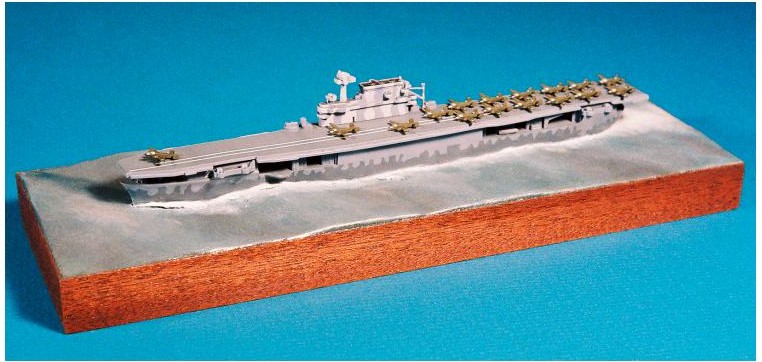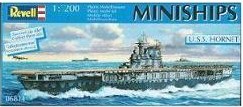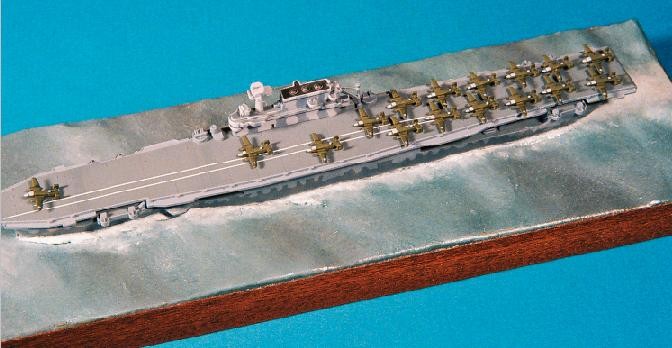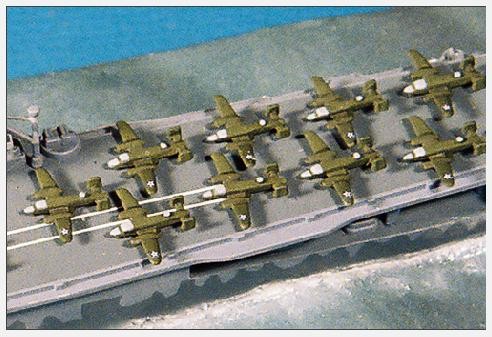
Revell AG 1/1200 USS Hornet
| KIT #: | 06814 |
| PRICE: | $3.75 |
| DECALS: | Yes |
| REVIEWER: | Tim Reynaga |
| NOTES: |

| HISTORY |
Surely the USS Hornet (CV8) is among the most famous of US Navy ships. Active only for the space of less than nine months, she was in the thick of carrier combat in the first year of the Pacific War. Her most famous moment was the Doolittle Raid in April, 1942, when sixteen Army B-25s took off from her deck for the first raid on Tokyo. During the Battle of Midway in May 1942 Hornet's Torpedo Squadron Eight was completely wiped out attacking the Japanese carriers, but her dive bombers participated in the sinking of the cruiser Mikuma. In August-September 1942, Hornet was the only carrier available to oppose the Japanese during the campaign for Guadalcanal. In October her fliers mauled the Japanese carrier Shokaku during the Battle of the Santa Cruz Islands, but Japanese carrier planes also hit Hornet. Fatally damaged, Hornet was abandoned and later sent to the bottom by Imperial Navy destroyers.
| THE KIT |
 As with many of the Revell
Germany 1/1200 line, Hornet
is a repop of an old molding released variously over the years by Casadio
"Mini-Ships", Altmark, ESCI/ERTL, Modelpower, MPC, and probably others.
This toy/model from the early 'seventies is very simplified, snap-together
affair designed for quick building. Interestingly, the kit was designed to
be issued as Hornet's
near-sisters Enterprise
and Yorktown
as well. As a result, there were a number of differences in each release
such as alternate airplanes, armament, different islands, even differently
positioned elevators. The present issue has a mix of features from all
three sisters, and so is not technically correct for any one ship. Hull
shape is only generally accurate, with an ugly blunt bow that looks more
like that of a tanker than a sleek aircraft carrier. The decals included
by Revell include outrageously wide yellow lines for the flight deck and an
overlarge "Hornet" name in white letters for the stern.
As with many of the Revell
Germany 1/1200 line, Hornet
is a repop of an old molding released variously over the years by Casadio
"Mini-Ships", Altmark, ESCI/ERTL, Modelpower, MPC, and probably others.
This toy/model from the early 'seventies is very simplified, snap-together
affair designed for quick building. Interestingly, the kit was designed to
be issued as Hornet's
near-sisters Enterprise
and Yorktown
as well. As a result, there were a number of differences in each release
such as alternate airplanes, armament, different islands, even differently
positioned elevators. The present issue has a mix of features from all
three sisters, and so is not technically correct for any one ship. Hull
shape is only generally accurate, with an ugly blunt bow that looks more
like that of a tanker than a sleek aircraft carrier. The decals included
by Revell include outrageously wide yellow lines for the flight deck and an
overlarge "Hornet" name in white letters for the stern.
Still, the kit has some cool features. I liked the full hangar deck and open side doors. There are even carrier planes to place in the hangar deck which are just visible through the doors. I also liked the deckload of tiny B-25s. And it really does snap together just about as fast as you can tear the parts from the trees...
| CONSTRUCTION |
Snap together it may be, but
the fit was not all that great. Parts had a good deal of flash; lotsa
trimming away with the x-acto. I had a hard time getting the flight
deck to snap down onto the hull. I ended up just forcing the damn
thing! (It's funny; this is the
 same experience I
had building this kit as a kid back in the seventies; either my skills
haven't advanced that much or kits really were harder to build then...!)
The island fit fairly well once I removed the locator blobs and sanded the
bottom flat. Boats, crane, and masts, though basic, went on without
any difficulty.
same experience I
had building this kit as a kid back in the seventies; either my skills
haven't advanced that much or kits really were harder to build then...!)
The island fit fairly well once I removed the locator blobs and sanded the
bottom flat. Boats, crane, and masts, though basic, went on without
any difficulty.
The aircraft included are very small, and unfortunately very crude as well. The B-25s are just discernable as such, and the smaller carrier planes are unrecognizable as any specific type. They are covered in flash and attach to the deck with large pegs which fit into corresponding holes in the hangar and flight decks. Fortunately they are so miniscule they don't look too bad once painted and in place.
I didn't even try to correct the various inaccuracies in the kit. It was hard to do at first, but I ignored those 40mm quads (never carried by Hornet), missing 20mm mounts, incorrect boat arrangements and other discrepancies and just forged ahead. This approach yielded a completely assembled model in less than an hour!
| COLORS & MARKINGS |
 I had put Hornet
together out of the box as a painting experiment to test out the White
Ensign Models Colourcoats line of paints (I plan to do a 1/350
Hornet eventually). The
colors used were US 05 Late 1941 5-11 Haze Grey (for the island), US 06
Late 1941 5-0 Ocean Grey (the stripes on island and for the upper hull),
and US 08 5-N Navy Blue (the lower part of hull to the waterline). The
flight deck was painted US 11 Flight Deck Stain 21. The paints worked
beautifully, and the intricate camouflage was fun to apply.
I had put Hornet
together out of the box as a painting experiment to test out the White
Ensign Models Colourcoats line of paints (I plan to do a 1/350
Hornet eventually). The
colors used were US 05 Late 1941 5-11 Haze Grey (for the island), US 06
Late 1941 5-0 Ocean Grey (the stripes on island and for the upper hull),
and US 08 5-N Navy Blue (the lower part of hull to the waterline). The
flight deck was painted US 11 Flight Deck Stain 21. The paints worked
beautifully, and the intricate camouflage was fun to apply.
I tossed the inaccurate kit decals, applying 1/64 inch white dry transfer lines from Woodland Scenics to the flight deck instead. The Army aircraft on deck were painted olive drab with gray to represent the glass areas. Early war US stars on their upper wings came from the excellent Navalis line of decals.
| CONCLUSIONS |
Though simplified in design and full of inaccuracies, I actually enjoyed Casadio-Altmark-ESCI/ERTL-Modelpower-MPC-Revell Germany's Hornet. Sure the old girl has been around, but she's still good for a cheap weekend!
November 2005
If you would like your product reviewed fairly and fairly quickly, please contact the editor or see other details in the Note to Contributors.